Building the essay
Aims
Building the essay is the constructing and composing stage of the writing process. It involves
- developing ideas logically in individual paragraphs
- including only ideas that are relevant to the central focus of the essay
- ensuring that each paragraph flows smoothly and logically to the end of the essay
If you have planned well, by the time you come to write the first draft of the essay, you should know where you are going, how you will answer the question, and roughly how many main points you will have in the body of the essay within the given word limit.
In this section, you will learn how to:
- construct an effective introduction that shows your understanding of the question and the key issues to be discussed
- build key ideas into unified and coherent body paragraphs
- write a strong conclusion to end your essay effectively
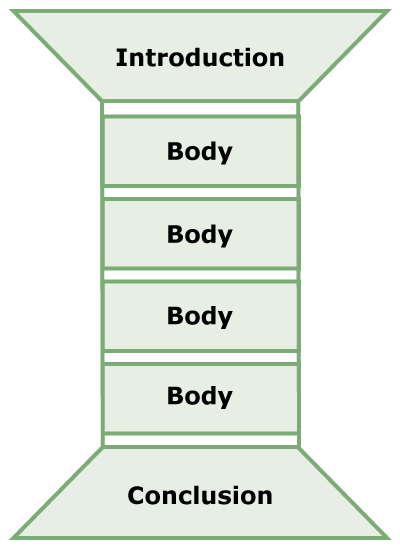
Introduction
"The introduction and conclusion to a paper can be understood as a type of transition ... the introduction serves as a transition by moving the reader from the world outside of your paper to the world within.[...] the conclusion works in the opposite direction by moving readers from the world of your paper to their own world."
 Commonly asked questions about introductions
Commonly asked questions about introductions
When should the introduction be written - first or last?
For undergraduate essays (between 700 and 3000 words), it is advisable to write the introduction first (even if it is just a draft). At the very least, you should have a tentative thesis (point of view) about the topic. The introduction defines the topic, clarifies the context, and prepares the reader for the discussion to come. As the writer, you will find it easier to build the body of the essay if you know what the scope (main discussion points) of the essay is.
What information should be included in the introduction?
In the Planning the essay section, you learned that the introduction of an essay has the following features: the background or context to the topic, the topic introduction, a thesis statement, scope, and appropriate length. Ideally, the main ideas identified for the scope of the essay should be written in the order that they would be discussed, to reflect the organisation of the essay (that is, telling the reader what to expect).
 Activity
Activity
Let us look at one introduction for this question:

A model for writing introductions
You may find writing introductions difficult because you think you have to construct something from nothing. This is not the case. This model is about building from and towards something.
In fact, if you have analysed the question carefully (using some of the tools from the Planning the Essay section), you will realise that the key content words you have identified fit well into the broad to narrow model and can immediately give you a logical way to start the essay.
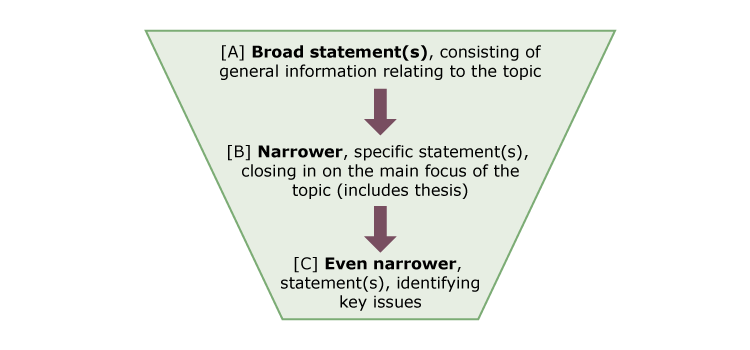
Here is an example of how the initial analysis of the question (using the bull’s eye strategy) translates quite easily into the broad to narrow model.
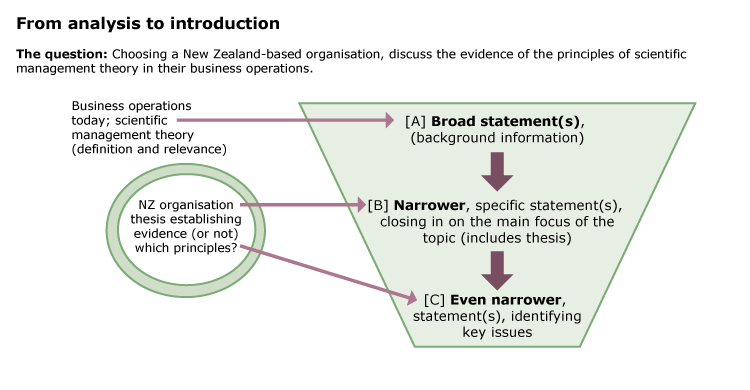
The broad to narrow model: an application
View the introduction to the essay question, Discuss the effects of the unemployment benefit system on the New Zealand economy, developed using this model.
Hover over each section of the introduction to see its purpose.
 |
A word on the thesis statement
Most academic writing involves discussion and argument, so a thesis (usually found in the introduction) is expected. A thesis can only be arrived at after you have weighed up all the evidence you have collected. A thesis statement states the main point of your essay and your point of view (which is formed from your research). It usually consists of one or two sentences.
A thesis statement is useful for two reasons:
- For the writer: it helps you control what to include in your essay and how to organise your ideas.
- For the reader: it helps your reader to know quickly what approach you intend to take in the essay.
What is an effective thesis statement?
Click through the slideshow to find out about thesis statements.
Practice 1
 Scrambled introductions
Scrambled introductions
In this activity, each set of sentences form an introduction, but they are not in the correct order (ie, each set is a scrambled introduction). Revise the introductions by putting the sentences in the correct order to reflect the broad to narrow model. Can you identify the thesis statement?
Body paragraphs
The topic must now be described, discussed and developed in unified and coherent body paragraphs.
What is a paragraph?
A sentence is a group of words that convey a complete thought; a paragraph is a group of sentences that advances the thought further. A paragraph introduces and develops one controlling idea or one aspect of an idea related to the central focus and thesis of the essay.
Formatting
A paragraph’s first sentence is often indented a few spaces with further spacing between paragraphs. Note: Indentation is not always required, if you have spacing between paragraphs. Check with your department about the style you should use. In typed scripts, spacing between paragraphs must be clearly visible and consistent with conventions or departmental guidelines. Whatever format you use, paragraphing – making divisions in the text – is essential. When done well, paragraphing improves the reader’s understanding of your writing.
Which text is easier to read?
Below are two versions of a text: one with and one without paragraph divisions. It is clear that version 2 is easier to read because the ideas have been separated out. The reader can see that there is an introduction, three main points and a conclusion.
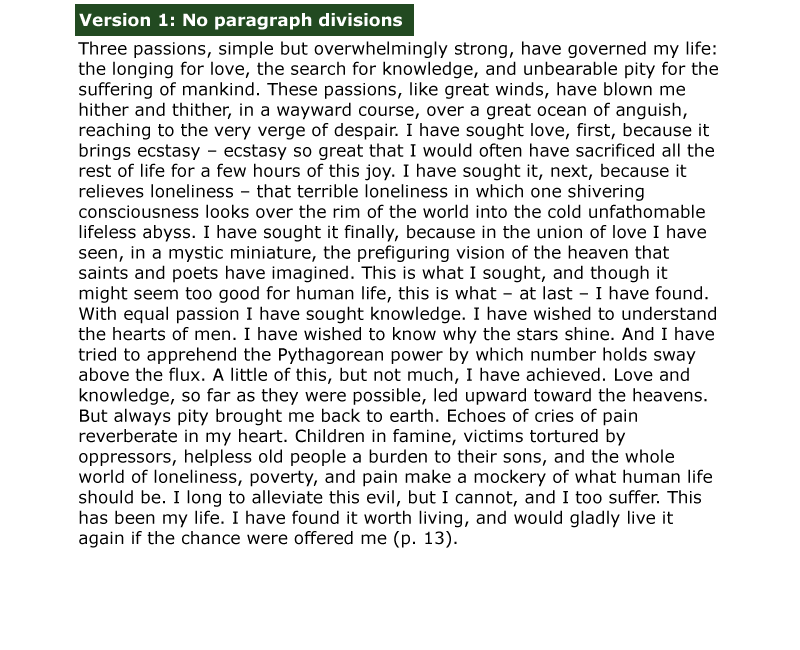
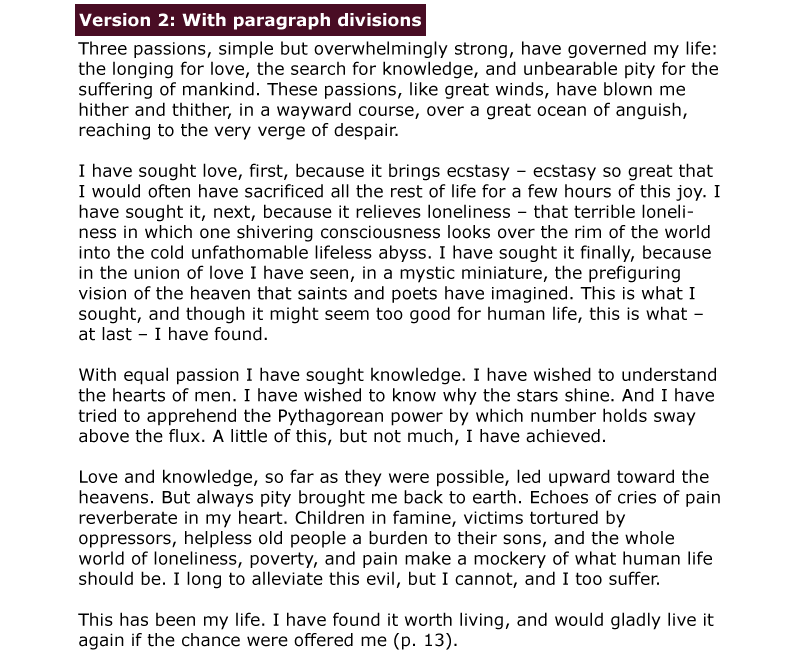
|
Number of paragraphs and paragraph length
Go to the Organise ideas tab in the Planning the Essay section for a simple way of working out how many body paragraphs of an appropriate length you should have.
Unity and coherence
A paragraph has unity if all the facts, examples, reasons and other details included in it are relevant to the idea introduced at the start of the paragraph. A paragraph has coherence if all the ideas are related to each other in a logical sequence, with each sentence building on the previous sentence.
The SEC model for paragraph construction
One of the difficulties that students have is building and developing an idea into a unified and coherent paragraph: there may be more than one controlling idea in the paragraph; the paragraph may be too short; or the ideas are not logically developed.
The SEC model is easy to use and ensures that each body paragraph is developed logically and unity and coherence are maintained throughout. The following is the first body paragraph from Bertrand Russell’s prologue to his autobiography, which is a classic example of a well-constructured, unified and coherent paragraph. He writes about the first of three passions that have governed his life-love.
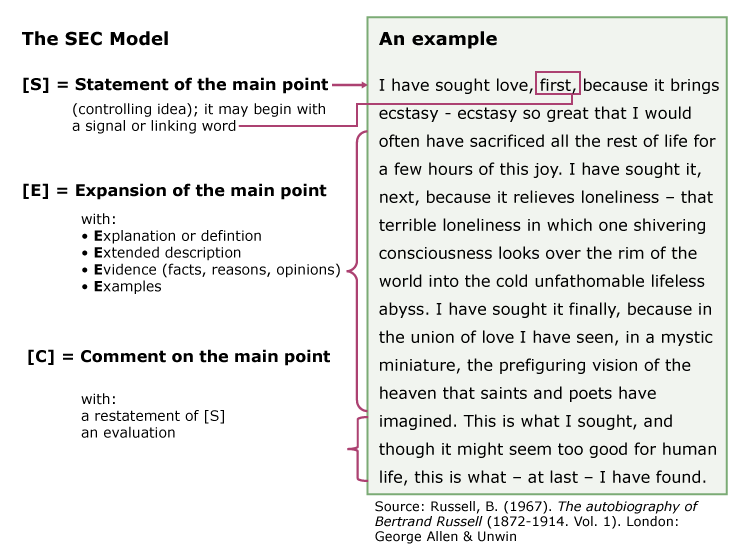
Paragraph construction: The SEC Model
The presentation below shows how a paragraph is constructed using the SEC model.
Practice 2
 Identifying topic sentences
Identifying topic sentences
 Building a body paragraph
Building a body paragraph
Now you try. Choose another main point from the map of ideas for the question “The motorcar has wrecked civilisation”, or use the model with an essay you are working on.
- Write an appropriate topic sentence to introduce the point [S].
- Then write another 8 to 10 sentences to expand the point made in the topic sentence, with details, evidence and specific examples [E].
- Write a final comment to finish your discussion of this point [C].
Conclusion
“Great is the art of beginning, but greater is the art of ending.”
Conclusions are difficult because you feel that you have nothing left to say and you are merely repeating the same information. On the contrary, the conclusion is your last chance to impress. It is often what your reader remembers best. It should, in fact, be the best part of your essay.
Here is a model for constructing an effective conclusion. You can see that it is the opposite of the introduction (Broad to Narrow) model.
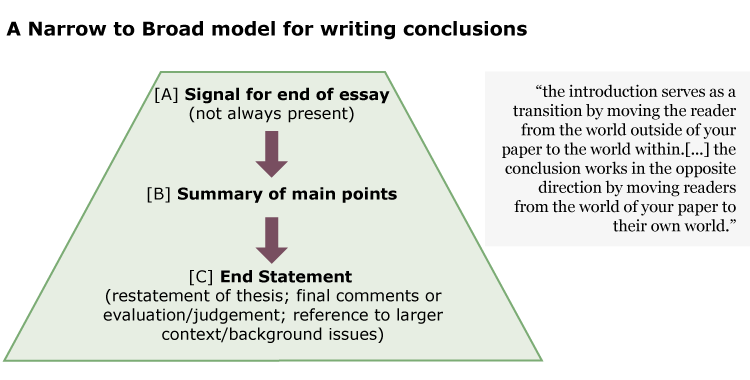
Click here to view an example conclusion.
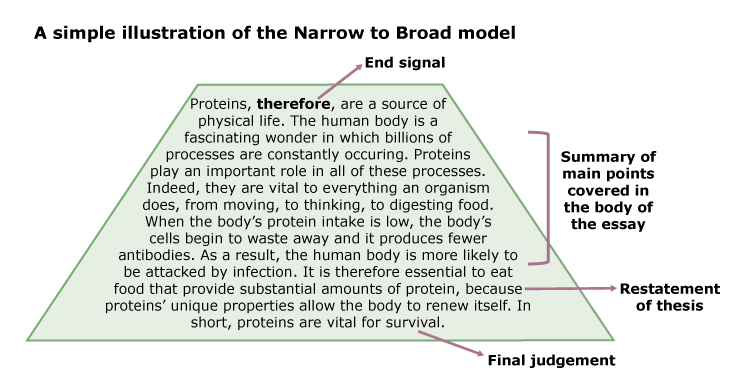
Practice 3
 Scrambled conclusions
Scrambled conclusions
Earlier you looked at the scrambled introductions for The changing styles of rock and roll music and The motorcar has wrecked civilisation. Below are the scrambled conclusions for these topics. Put the sentences in the correct order to reflect the narrow to broad model:
1. The changing styles of rock and roll music
Rearrange the sentences so they fit the narrow to broad model.
Text source: Oshima, A. & Hogue, A. (1997). Introduction to academic writing (2nd ed.). N.Y.: Addison Wesley Longman. (modified)
2. The motorcar has wrecked civilisation
(This conclusion restates the thesis that the motorcar has wrecked civilisation.)
Rearrange the sentences so they fit the narrow to broad model.


















